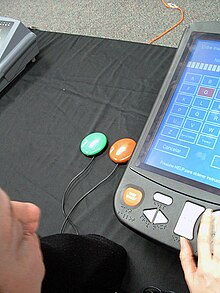DRE voting machine: Difference between revisions
remove content not specifically related to topic, as well as content duplicated on electronic voting |
fix ie layout |
||
| Line 3: | Line 3: | ||
In 2004, 28.9% of the registered voters in the United States used some type of direct recording [[electronic voting]] system, up from 7.7% in 1996. |
In 2004, 28.9% of the registered voters in the United States used some type of direct recording [[electronic voting]] system, up from 7.7% in 1996. |
||
[[Image:Jellybuttons.jpg|thumb|A Hart eSlate DRE voting machine with jelly buttons for people with manual dexterity disabilities.]] |
[[Image:Jellybuttons.jpg|thumb|left|A Hart eSlate DRE voting machine with jelly buttons for people with manual dexterity disabilities.]] |
||
==See also== |
==See also== |
||
Revision as of 01:47, 9 March 2009
| Part of a series on |
| Election technology |
|---|
| Technology |
| Terminology |
|
| Testing |
| Manufacturers |
| Related aspects |
A direct-recording electronic (DRE) is one for of electronic voting machine which records votes by means of a ballot display provided with mechanical or electro-optical components that can be activated by the voter (typically buttons or a touchscreen); that processes data by means of a computer program; and that records voting data and ballot images in memory components. After the election it produces a tabulation of the voting data stored in a removable memory component and as printed copy. The system may also provide a means for transmitting individual ballots or vote totals to a central location for consolidating and reporting results from precincts at the central location.
In 2004, 28.9% of the registered voters in the United States used some type of direct recording electronic voting system, up from 7.7% in 1996.

